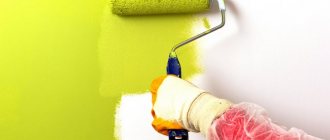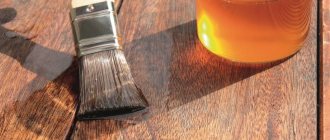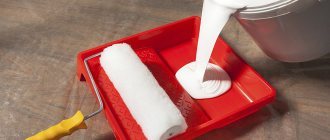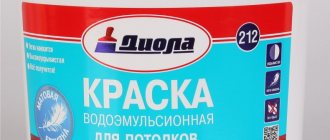Thin the oil paint
Probably everyone can remember a similar incident: during the renovation period, more than once, due to their own carelessness, they forgot to close a can of paint, which, to their great disappointment, caused the material to harden and was no longer suitable for use.
Below are examples of possible paint solvents that will help you save thickened paint, or simply dilute new paint. Oil paints, by themselves, can be either thickly rubbed or immediately have the consistency necessary for their application. Paints, conventionally called “thick”, are used extremely rarely in this form; most often they are diluted with a solvent. Also, already dried paints or those that are planned to be used as a primer are diluted with this specific liquid.
The type of paint solvent is determined according to the properties of the material on which the paint will be applied.
Oil paint can be easily diluted with many chemicals, which are extremely easy to purchase in hardware stores. Examples include the following solvents: turpentine (purified or not), gasoline, solvent 647 kerosene (only with the addition of a drier), white alcohol. However, white alcohol, thinner 647 and turpentine are by far the most widely used types of solvents.
Dilution procedure
No less important is the process of diluting the paint yourself, because its accurate implementation is the key to the absence of further problems.
Activities are carried out in the following order:
It is more difficult to thin paint that has been left open for a while. Work order:
Important! The work is carried out in compliance with increased precautions, since oil paint and all substances used for dilution are flammable and toxic.
White spirit for oil paints
The scope of the same white spirit is extremely wide. It is serious competition for turpentine, whose sales volumes fell after white alcohol appeared on the markets.
White spirit for oil paints is used in the following cases:
- To obtain an organodispersion when diluting paint and varnish coatings.
- For the purpose of diluting varnishes, primers, drying oils, enamels, car preservatives, etc.
- Used for washing brushes after finishing work.
- In order to degrease the surface if this kind of problem suddenly arises.
- Can be used as a solvent for rubber or alkyds.
This solvent is extremely popular due to its availability, because its price is quite reasonable, even taking into account the wide range of its applications.
When using white alcohol, the cost of paint or other type of paint coating is significantly reduced, but the quality of the paint remains unchanged.
If desired, it is even possible to find a type of white alcohol that does not have its characteristic pungent odor.
Rules for using white spirit for oil paints:
- We should not forget about safety precautions, so you should avoid finding solvents near any open flame sources or switches. It is also worth paying attention in advance to the fact that solvents of some compositions can spontaneously ignite under the influence of temperatures.
- You also need to pay attention to the rather pungent odor of the substance. Therefore, paint should be diluted only in well-ventilated areas or even in the open air.
- Due to the chemical composition of solvents, they should not come into contact with the skin or mucous membranes. Otherwise, you must immediately rinse the area where the substance comes into contact with water. Clothes can also be damaged by exposure to strong chemicals.
Advantages of oil paints:
Dense and pure colors. These paints are easily mixed, so you can get almost any desired shade and color, no matter whether it is dark or light, bright or muted. Unlike acrylic paint, oil paint remains wet on the canvas for a long time. This allows you to mix the desired colors directly on the painting. These paints can be applied directly on top of each other in several layers
At the same time, the colors do not become cloudy, as happens with watercolors. An equally important feature of oil paints is that it is very easy to correct mistakes when working with them. This type of paint can be easily removed from the surface of the canvas using various tools.
For these purposes, you can use a palette knife, spatula or a regular cloth. If the layer of oil paints has already dried, you can apply a new layer on top of it.
Oil painting is one of the most popular types of fine art. This is due to the brightness and durability of the work. In addition, working with this material is extremely easy and pleasant.
In this regard, it is important to know how to dilute oil paints
Turpentine for oil paints
Turpentine is currently a popular paint thinner. In addition, it is used in the production of rosin, as well as dammar. It can also be found in copal-based varnishes. The composition of turpentine is complex, and in itself it is like an essential oil.
Types of turpentine for oil paints:
- Stump turpentine. It is made mainly from the bark of coniferous trees, as well as stumps.
- Wood turpentine. In production, tree branches and bark, which contains resin, are used. In its original form, such turpentine is a brownish liquid, which disappears immediately after repeated processing.
- Turpentine turpentine. This type of solvent can only be compared with real essential oil, since it is obtained by distilling the resin and resinous materials of various types of coniferous trees. The valuable properties of this oil are not lost even after secondary processing, which is its undoubted advantage.
Solvent 647 for oil paints
Solvent 647 is a fairly strong, colorless chemical that is highly flammable and also emits a strong, unpleasant odor, which is quite typical for this type of solvent. This liquid is often used to dilute alkyd enamels and pentaflathein enamels. They are often used to dilute varnishes or putty. The surfaces to be painted are first degreased with a solvent. Various industrial tools and parts are also washed with this liquid, and in addition, solvent 647 is used to clean contaminated fabric.
When diluting paint, you should be extremely careful in its ratio of solvent, since if the amount of solvent is incorrect, the paint can easily be damaged. In diluted form, the paint is used for better penetration into the surface material. A mixture of paint and solvent is also used as a primer.
Mix it well for 10-20 minutes until smooth.
Features of working with acrylic
Acrylic paints can be diluted with water or other thinners that will change their properties when drying. For example, you can add gloss by mixing with varnish or, conversely, matte with oil. You can also add shine using hairspray by sprinkling it after the paint has dried. Thanks to the solvent, it is possible to improve the fluidity of acrylic so that it is convenient to paint large surfaces or work with a paint roller.
They can be used for priming canvases and other surfaces. Using acrylic, you can get both a smooth base and a textured one.
We'll tell you and teach you
Many, if not most, home craftsmen are familiar with this situation: they opened a can, and the paint in it was thickened. It doesn’t matter - it can always be dissolved.
Basic rules for diluting paints
The most important rule is that like dissolves like. Agree, it is stupid to use acetone to dilute oil paint and expect that the dissolved paint will be of a uniform consistency and without curdled clumps.
Therefore, first of all, carefully study the label on the can of paint and understand its composition. At worst, at least find out the type of paint in the can.
Start thinning the paint with a small test amount. Having placed just a little bit of thickened paint in a small bowl, add a little of the required thinner to it and if, after thorough mixing, it acquires the necessary viscosity without losing its properties, you can safely begin to dissolve the main volume of paint.
Be careful with the amount of thinner, add it to the paint in small portions.
Remember: you can almost always make liquid paint from thick paint, but it is very difficult to make thick paint from liquid paint.
After thinning the paint, before starting painting work, get rid of debris and undissolved elements by straining it through a sieve or layer of gauze.
Water-dispersion paints
As the name suggests, these paints consist of water, pigment and a binder.
The process of dilution with drying oil
Thinning the paint is not difficult, but you should proceed step by step and sparingly add any diluent, because if it is oversaturated with drying oil, then it will take a longer time for the surface to dry.
Breeding stages:
- for the convenience of stirring and eliminating clots, transfer the paint and varnish substance to a suitable container;
- pour in drying oil in small portions and begin to mix thoroughly, monitoring the thickness;
- repeat the procedure of adding oil and bring the mixture to a consistency that suits us;
- wait about ten minutes, then strain the mixture through a sieve to remove any lumps.
If you add too much drying oil, the paint will take much longer to dry.
What's in it?
The composition of alkyd painting materials largely determines the properties and characteristics of varnishes, paints and primers. In general, any paint and varnish material contains ingredients such as:
- coloring pigments;
- various excipients;
- thinners;
- driers – substances that accelerate drying, etc.
As for alkyd paints, they contain alkyd polymers (resins) as foaming agents . But depending on the type of resin, pentaphthalic and glyphthalic binders are distinguished, and, accordingly, pentaphthalic (marking - PF) or glyphthalic (GF) enamels, primers and varnishes are produced. In addition, on alkyd drying oil, in addition to traditional liquid ones, thickly grated compositions are also produced (GF-013, PF-014, etc.). Enamel painting material, or simply enamel, is a paint with which you can obtain not a matte, but a glossy or even mirror-like surface.
The segment of alkyd materials includes paints having the following base:
- drying oil (marking – MA);
- glyphthalic and pentaphthalic varnishes (marking – GF and PF);
- oil-phenolic varnish (marking – FA).
Solvents and thinners
When working with pentaphthalic and glyphthalic materials, sometimes it becomes necessary to dilute them to the desired consistency.
For these purposes, special thinners are used. In the case of alkyd paints, thinners are also solvents, i.e. substances that can dissolve enamel coatings. In turn, the purpose of the thinner is to thin the paint and help create a uniform film. But solvent substances dissolve paints and enamels, then evaporate, thereby weakening the paintwork. Such volatile substances include white spirit, turpentine, solvent and gasoline solvent, as well as special substances that serve as solvents for certain painting materials.
The main thinner for paints based on alkyd polymers is white spirit, solvent, turpentine, xylene, gasoline solvent Nefras-S 50/170, RS-2, as well as mixtures of these reagents.
Depending on the type of material, different substances can serve as diluents, for example:
- RS-2, turpentine, as well as white spirit, solvent or a mixture of any two thinners in a 1:1 ratio serve as a thinner for PF-14, PF-1217 enamels.
- White spirit dilutes PF 1126 enamel.
- RS-2, turpentine, solvent (gasoline), white spirit, solvent, xylene or mixtures thereof act as thinners for enamels GF-230, PF-560, PF-115, PF-223.
- GF-1426 enamel is dissolved to the required consistency, using both xylene and solvent, or using a mixture of any of the above with white spirit.
When working with substances and mixtures that dissolve or dilute enamels, a number of nuances should be taken into account.
How to dilute?
PF or GF enamels are sold ready for application and with the degree of thickness that best matches the composition of the material. However, if the composition needs to be diluted, it is necessary to add only the minimum amount of diluent, for example:
- If external painting is necessary, then the finished paint should be diluted by adding a thinner in an amount of no more than 3% of the total volume of enamel.
- For interior work, the finished paint should be diluted with a thinner amount of no more than 5% of the total volume.
- If you dilute the composition with a large amount of thinner, the enamel flows down (in particular, from vertical planes) and forms streaks. In addition, the performance characteristics of the paintwork are reduced.
It should be noted that the material composition and percentage of ingredients in painting materials is not accidental and is the result of many years of experience . Therefore, the desire to improve the quality of a painted surface by adding a thinner in an arbitrary amount often leads to a deterioration in the characteristics of the coating.











